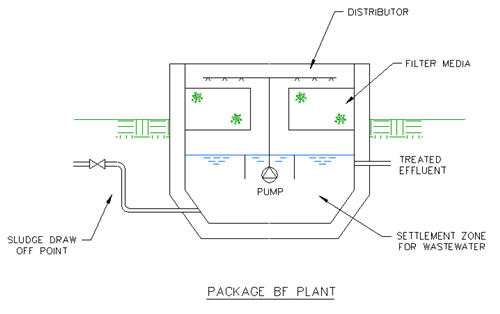Biological filtration secondary treatment system
Biological filters (BF)
Biological filters can be used in the treatment of screened raw sewage or settled wastewater from primary settlement (sedimentation) tanks. The filter plant consists of a bed of random or modular plastic media through which the effluent percolates.
A rotating distributor arm or a series of fixed nozzles at the top of the filter drizzle the wastewater over the top of the bed. Channels in the plastic medium enable natural ventilation of the beds with air, to provide oxygen which is required by the biomass to oxidize the biochemical oxygen demand (BOD). Drains under the beds carry the treated effluent to a humus tank where any solids that have sheared away from the media (sloughing) can be settled out to leave a clarified effluent.

Package plant variants
The package plant modules usually incorporate the filter in the top of the module and the humus tank in the bottom section. Pumps are used to lift effluent to the distributor, which is usually of the fixed-type; with splash plates to spread the effluent over the top of the filter bed.
The filters generally contain plastic media and the wastewater trickles to the humus tank where the solids can settle and the effluent can overflow to drains. A sludge pump is used to transfer the settled sewage at the bottom of the chamber to a septic tank.
Sewerage Services
Sewerage Systems
Package Sewage and Wastewater Treatment Plant
Biological Filtration Secondary Treatment System
Rotating Biological Contactors
Biological Aerated Filter
Submerged Aerated Filters
The Treatment of Sewage using Activated Sludge
The Secondary Treatment of Sewage using a Sequencing Batch Reactor
Water Services >>

